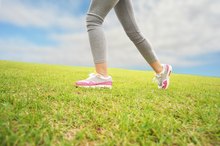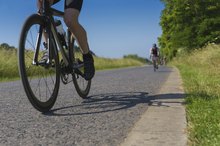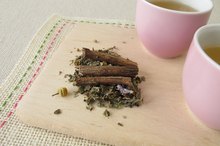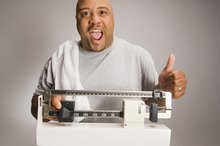Exercises for an Anal Fissure
Anal fissures are tears in the lining of the anus, the opening through which stools pass from your body. They can also leave tags hanging from the anal opening. Anal fissures are fairly common and usually produce symptoms such as burning, pain and bleeding, particularly during or after a bowel movement. Hard, large bowel movements are usually the cause of fissures, but diarrhea and rectal irritation are also culprits. Your doctor may recommend ointments or suppositories, but you can also encourage healing through exercise.
Yoga Poses
If your anal fissures are the result of constipation or large, hard stools, yoga may help. For instance, the Dhanurasana pose helps relieve constipation and promote digestion, notes WomenFitness.net. In addition, the Pavanamukta asana and Trikonasana pose stimulate the abdominal region, thus relieving constipation. For proper performance of these poses, consult a yoga trainer or enroll in a yoga course.
- If your anal fissures are the result of constipation or large, hard stools, yoga may help.
- In addition, the Pavanamukta asana and Trikonasana pose stimulate the abdominal region, thus relieving constipation.
Moderate-Intensity Exercises
How to Reduce Scar Adhesions
Learn More
According to MayoClinic.com, 30 minutes of moderate-intensity exercise, such as walking, can help heal fissures. Walking helps encourage regular bowel movements, limiting the onset of large stools that harden and become difficult to pass. In addition, the exercise promotes overall blood flow. This encourages healing, subsequently aiding in the treatment of fissures. Other moderate-intensity exercises include vacuuming and mowing.
- According to MayoClinic.com, 30 minutes of moderate-intensity exercise, such as walking, can help heal fissures.
- This encourages healing, subsequently aiding in the treatment of fissures.
Bath Exercise
This exercise promotes blood flow to the area, allowing for maximum healing. To start, fill a tub as high as possible with warm water. While sitting in the tub, contract the muscle used to stop the passage of stool from the anus. Next, concentrate on relaxing this muscle. Perform this contraction and relaxation every 5 minutes while in the tub. Take baths in the tub three times a day, performing this exercise during each bath.
- This exercise promotes blood flow to the area, allowing for maximum healing.
- Take baths in the tub three times a day, performing this exercise during each bath.
Considerations
Does Cycling Make Hemorrhoids Worse?
Learn More
While exercise may help heal anal fissure, other lifestyle alterations may provide maximum healing benefits. In addition to exercise, do not strain during bowel movements, as this can open tears or cause new ones. Also, increase your intake of fiber to between 25 and 35 g a day, as this keeps stools soft and promotes healing. For fibrous foods, look to fruits, vegetables and nuts such as pears, raspberries, potatoes, peas and almonds.
- While exercise may help heal anal fissure, other lifestyle alterations may provide maximum healing benefits.
- In addition to exercise, do not strain during bowel movements, as this can open tears or cause new ones.
Surgical Possibilities
Half of all fissures heal on their own or with self-treatment in several weeks; however, your fissures may require surgery for removal. Surgery is generally an option if you have persisting symptoms or if you experience scar tissue or spasms in the sphincter muscle. Surgery involves cutting a part of the sphincter muscle to release tension and promote healing in the sphincter. However, surgery may cause loss of bowel control and involuntary incontinence. Consult your physician to determine if surgery is necessary.
- Half of all fissures heal on their own or with self-treatment in several weeks; however, your fissures may require surgery for removal.
- Surgery is generally an option if you have persisting symptoms or if you experience scar tissue or spasms in the sphincter muscle.
Related Articles
References
- American College of Gastroenterology: Rectal Problems
- Women Fitness: Yoga to Heal Constipation
- Mayo Clinic: Anal Fissure: Lifestyle and Home Remedies
- Bupa: Anal Fissure Q & A’s
- University of California San Francisco Medical Center: Anal Fissures
- Sugerman DT. Anal fissure. JAMA. 2014;311(11):1171. doi:10.1001/jama.2014.214
- Gardner IH, Siddharthan RV, Tsikitis VL. Benign anorectal disease: hemorrhoids, fissures, and fistulas. Ann Gastroenterol. 2020;33:9-18. doi:10.20524/aog.2019.0438
- Mapel DW, Schum M, Von Worley A. The epidemiology and treatment of anal fissures in a population-based cohort. BMC Gastroenterol. 2014;14:129. doi:10.1186/1471-230X-14-129
- Lang DS, Tho PC, Ang EN. Effectiveness of the Sitz bath in managing adult patients with anorectal disorders. Jpn J Nurs Sci. 2011;8(2):115-28. doi:10.1111/j.1742-7924.2011.00175.x
- American Heart Association. Whole grains, refined grains, and dietary fiber. Updated September 20, 2016.
- Cleveland Clinic. Anal fissures: Management and treatment. Updated February 22, 2019.
- American Society of Colon & Rectal Surgeons. Anal fissure expanded information.
- Cleveland Clinic. Anal fissures: Prevention. Updated February 22, 2019.
- U.S. Department of Health and Human Services and U.S. Department of Agriculture. 2015 – 2020 Dietary Guidelines for Americans. 8th Edition. December 2015.
Writer Bio
Sarah Thompson has been a writer since 2006. She has contributed to Ohio-based publications such as "CityScene" and "Dublin Life" magazines, as well as Columbus' top alternative weekly, "The Other Paper." Thompson has also written for several online outlets, including Smashing Magazine and Web Designer Depot. She holds a Bachelor of Arts in journalism, sexuality studies and visual communication design from Ohio State University.








